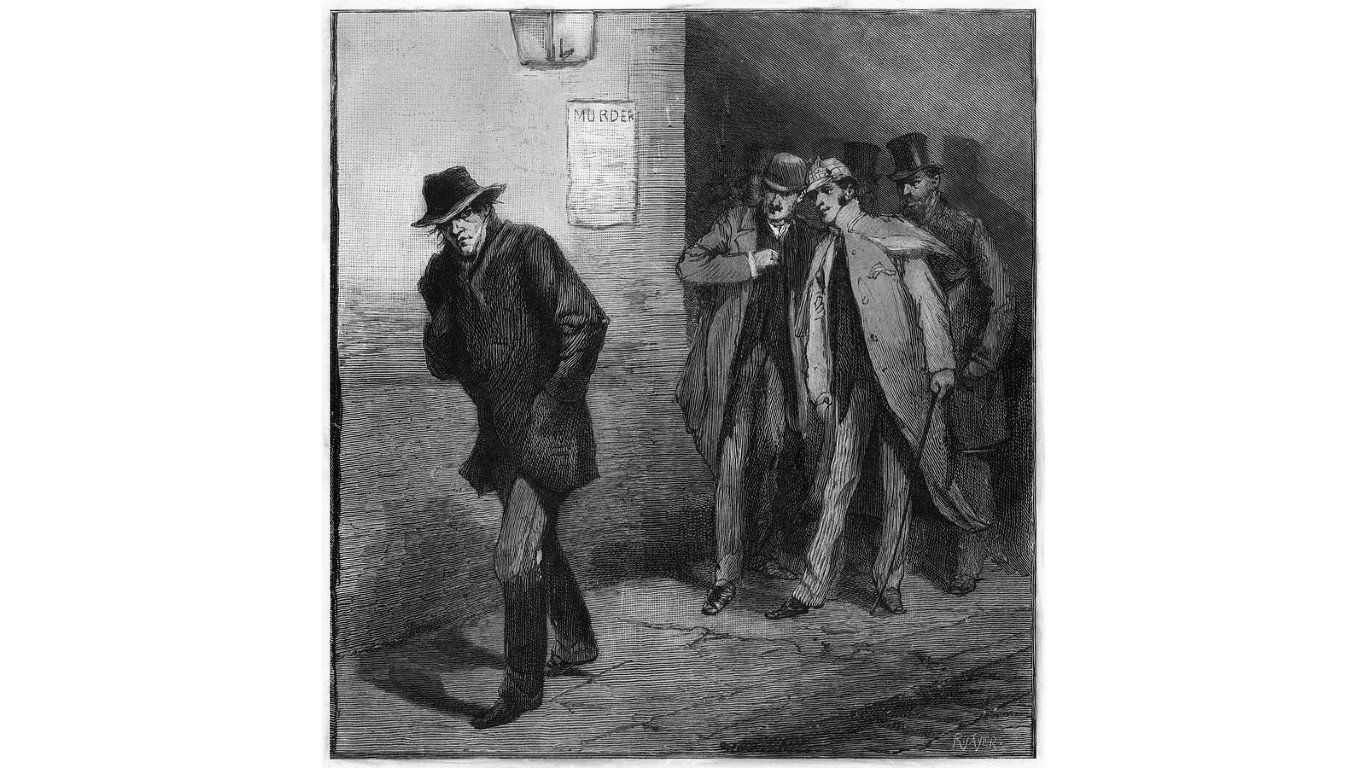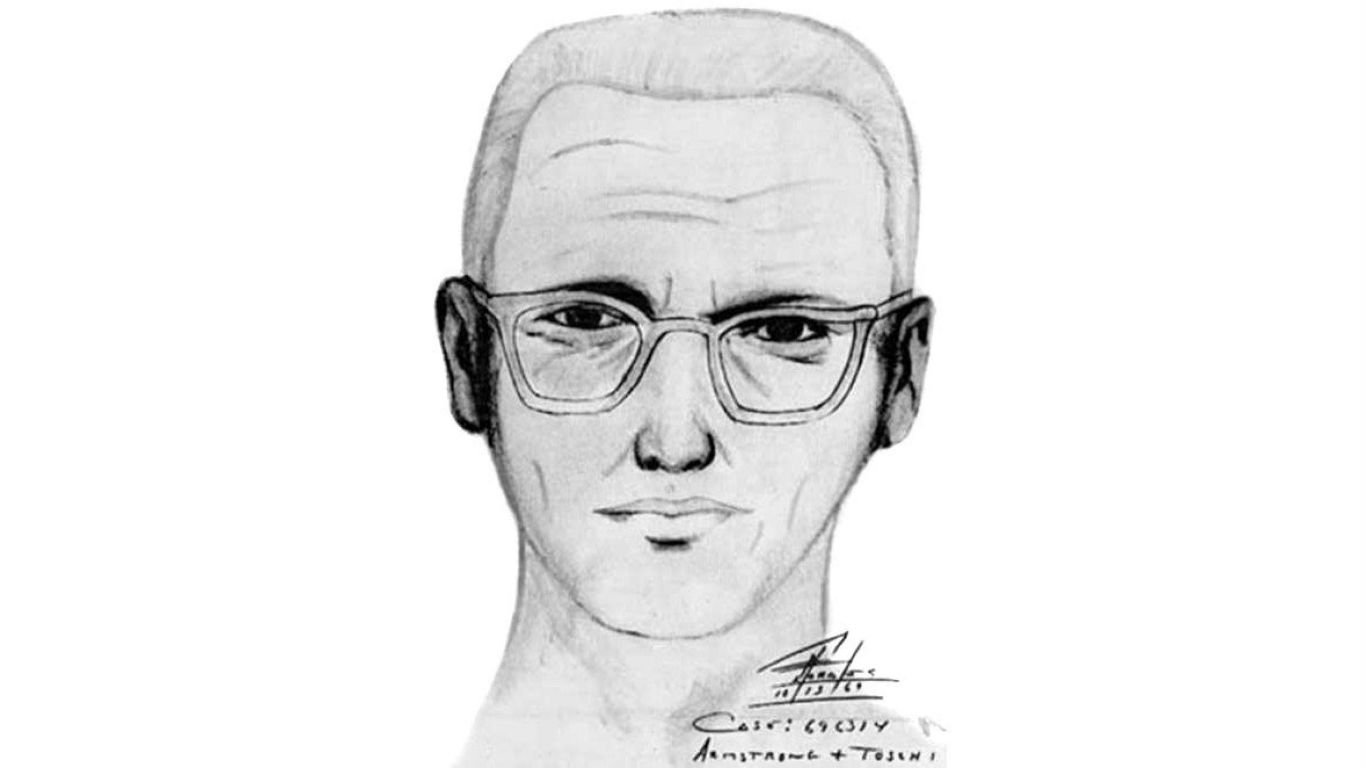A lot of people think of serial killing as a uniquely American problem. Violence is often associated unfairly with America. However, serial killers exist all over the world. Many murder cases go cold outside of the U.S. According to the FBI, a violent crime occurs every 24.6 seconds, and a murder occurs every 30.5 minutes.
Reddit user Chilaxinman did some math to estimate roughly how many murders you’ll meet in a lifetime and discovered that based solely on averages, you’re liable to have crossed paths with 16 murderers before you die.
In 2017, the FBI’s Uniformed Crime Report indicated that police had successfully and satisfactorily solved 61.6% of murders that occurred, which means around 40% of murders go unsolved. Additionally, the FBI estimates that there are around 50 active serial killers in the United States at any given time. So, let’s examine some examples of serial killers who were never caught by the authorities.
Determining this list was complicated as many published documents regarding serial killers have a bias toward American offenders. We didn’t want to make serial killing seem like a uniquely American problem. FBI research indicates that serial killing accounts for less than 1% of murders in the U.S. However, with 40% of homicides going unsolved, it may appear that serial killers are actually just getting away with their hobby. Thus, data on serial killing, particularly in the modern day, is quite limited. So, we compiled a list of notable serial killings across the globe, from the very famous to the lesser known. Then, we researched each killer and the incidents they were involved in. (These are the most prolific serial killers in history.)
1. Jack the Ripper

Jack the Ripper is the pseudonym of the serial killer who murdered at least five women in the Whitechapel district of London’s East End in the summer of 1888. Not only is the story of Jack the Ripper one of the most famous instances of unsolved crime in England, but it is also one of the most notorious instances of unsolved serial murder in the world. Additional murders committed between 1888 and 1892 were attributed to Jack the Ripper. However, only five—known as the “canonical five”—were definitively attributed to the same killer according to police forensics at the time.
The canonical five were Mary Ann Nichols, found August 31st, Annie Chapman, found September 8th, Elizabeth Stride, found September 30th, Catherine “Kate” Eddows, also found September 30th, and Mary Jane Kelly, found November 9th. In each instance, the victim’s throat was slit and the body was viciously mutilated in such a way that made it clear that the killer had some present knowledge of human anatomy. In one instance, half a human kidney was mailed to the police, presumably from a victim. Additionally, the authorities received several letters claiming to be from the killer, taunting them and referring to themselves as “Jack the Ripper” from which the case derives its name.
There are a few substantiated suspects in the case, although no one was ever definitively confirmed as the killer. Firstly, there is Montague Druitt, a local barrister who had an interest in surgery. He disappeared and was found dead shortly after the final killings. There is also Michael Ostrog, a Russian criminal and physician who was hospitalized in an asylum due to homicidal tendencies. Aaron Kosminski was implicated due to his hatred for women, especially prostitutes, and was hospitalized after the final murders.
2. The Zodiac Killer

The Zodiac Killer is an unidentified serial killer from America thought to have murdered at least five people in Northern California. He was active from 1968 until 1969. Some sources will attribute the 1966 murder of an 18-year-old college student in Riverside, California to the Zodiac Killer. However, police have never been able to prove his involvement definitively. The story of the Zodiac Killer inspired several action films, including Dirty Harry, starring Clint Eastwood in 1971, and the critically acclaimed drama, Zodiac, by David Fincher in 2007.
The first murders that were definitively tied to the Zodiac Killer were that of a teenage couple in 1968. They were shot to death near their car in a remote area near San Fransisco. Another couple in 1969 were attacked under similar circumstances. However, in this case, the male victim survived. Following this attack, the killer phoned the cops to confess to both the 1969 and 1968 attacks. Finally, the last known victim of the Zodiac Killer was a taxi driver, who was shot to death in October 1969. While some historians believe that the Zodiac continued to be an active serial killer after this, no airtight proof has tied him to any murders in the following years.
What makes the Zodiac Killer so well-known is the number of taunting letters and phone calls he made to the police regarding his crimes. Among these were four ciphers or cryptograms, that began with “This is the Zodiac speaking,” and ended with a signature symbol that appears to be a pair of crosshairs. His ciphers included chilling statements such as “I like killing people because it is so much fun.” and “I hope you are having lots of fun trying to catch me.”
3. The Family Murders

The Family Murders refers to a mostly unsolved series of five murders that occurred in Adelaide, Australia. The term “the Family” comes from an interview with a police detective that claimed the authorities were taking steps to “break up a happy family” where “family” refers to a loosely connected group of serial killers, largely thought to be Australian elites, that would kidnap, drug, rape, torture, and sometimes kill young men and teenage boys in Adelaide. Four of the five murders remain unsolved, while one person, Bevan von Einem, was convicted for one of the murders. The identities of the other members of the Family remain a mystery.
There were at least 150 young men in Adelaide who were drugged and raped, often by multiple men, during the Family’s active years. However, five of those men were also murdered. These five young men were kept captive for upwards of five weeks. During this time, they were repeatedly drugged, raped, tortured, mutilated, and ultimately killed. The five who never made it home were Alan Barnes, Neil Muir, Richard Kelvin, Peter Stogneff, and Mark Langley. Many of the victims were seen with Bevan von Einem or people who knew him before they disappeared.
While many people in von Einem’s social circle have been implicated in the murders, only von Einem was convicted. He was originally sentenced to a 24-year non-parole prison term, which was later extended to 36 years. He was later given an additional three months in prison when he was found with handwritten stories about having sex with young boys and men, which he claimed he kept as “insurance” against another prisoner who had made threats about him. His fingerprints were not found on any of the pages and they were kept in a sealed envelope in his cell.
4. The Doodler

The Doodler is an unidentified serial killer responsible for at least five murders in the San Fransisco area. The victims were all white gay men who met the killer at nearby gay clubs. The Doodler gets his name from his penchant for sketching his victims before brutally stabbing them to death. Each of the five bodies was stabbed several times in the front and back in roughly the same locations over all five bodies. Three men were assaulted by the Doodler but managed to escape death. However, they refused to testify to police, which the detectives assumed was to avoid being outed as gay.
While many of the key figures in the Doodler case have since passed, including the original detective who oversaw the investigation, new evidence has recently been unearthed that may lead to answers in this cold case. However, the evidence may lead to something less satisfying: a dead person. As the case has been cold for almost fifty years and many of the witnesses have also passed, the Doodler may be also no longer among us. While that would mean that, at a bare minimum, people are safe from him, it may be unsatisfying to the victims’ loved ones to know that he had lived a full life after claiming the lives of others.
Police hope that the DNA technology they are currently using to re-open the Doodler’s case might also lead them to the identity of the Zodiac Killer.
5. The Monster of Florence

A serial killer colloquially known as “Il Mostro di Firenze” (The Monster of Florence) was active from 1968 and 1985. During that time, the killer gunned down 16 people with a Beretta .22 caliber handgun. The targets were all young couples engaged in sexual activity in remote areas, and in many cases the female victims were mutilated.In several cases, the killer carved the female victim’s genitals out of the body altogether and kept them as a ‘souvenir’ from the murder. After the first set of murders in 1968, the female victim’s husband was convicted of the murders. However, the killings continued even after his confinement, leading to public panic and widespread fear.
Several convictions were made in conjunction with the case, the most notable being that of Stefano Mele, the first female victim’s husband, and Pietro Pacciani, a farmer who was convicted of seven out of eight killings. However, Pacciani’s initial trial was deemed invalid, and he died before a second trial could be conducted. New evidence may reopen the case. Prosecutors now believe that Pacciani wasn’t acting alone. He had been working with his friends Mario Vanni and Giancarlo Lotti to kill these couples. Five different men have been imprisoned at one time or another concerning the murders. However, they were subsequently released when more killings occurred during their confinement.
One suspect that investigators think was inadequately questioned was Giampiero Vigilanti, a close friend of Pietro Pacciani. Looking through his house, police uncovered a gruesome obsession with the Monster of Florence killings. He had newspaper clippings and bullets of the same type used in the murders.
6. Butcher of Mons
The Butcher of Mons is the colloquial name given to the unidentified serial killer guilty of killing at least five people in or near the Belgian city of Mons between 1996 and 1997. The killer systematically butchered the bodies and placed various body parts in garbage bags, which were then dumped in places with evocative names such as “rue du Dépôt”, “Avenue des Bassins”, and “chemin de Bethlehem”. In addition to body parts, brightly colored undergarments were found in the garbage bags. Despite the bodies being butchered and incomplete, the women were identified. All struggled with socioeconomic troubles and/or family issues.
Discoveries involving the Butcher of Mons began on March 22nd, 1997. A police officer came across nine garbage bags containing human remains near the Rue Emile Vandervelde in Cuesmes. The bags and contents were examined by a magistrate. It was determined that the body parts came from three different bodies, all women. Of the nine bags, five were determined to have come from the Knokke-Heist municipality. Another bag was found on the same street the following day. A tenth bag was discovered on the chemin de l’Inquiétude in Mons on March 24th. Two more bags were found on April 12th in the rue du Dépôt near the Haines River.
Several people were considered persons of interest during the investigation of the murders. The most notable was Smail Tulja. He was arrested in Montenegro under suspicion of having killed his wife in New York. He was also suspected of two murders in Albania. However, he was not extradited due to his citizenship and was tried and sentenced in Montenegro. He is reported to have died in prison in February of 2012. His involvement in the murders in Albania and Belgium was never confirmed.
7. Lisbon Ripper
The Lisbon Ripper was a serial killer active in Lisbon, Portugal from 1992 to 1993. During this time, three prostitutes were killed, disemboweled, and had some or all of their organs removed. Notably, the implement used to disembowel the victims and remove their organs was not a knife. Experts believe the killer used a scalpel for these activities. All three victims were young brunette women named Maria and were alleged prostitutes and drug addicts.
Portugal’s Judicial Police opened an official investigation into the case following the killing of Maria Fernanda, the second victim. A team of six men worked 24 hours a day on the case, sometimes with help from the drug trafficking division. They had suspects, but no evidence as investigation of the crime scenes yielded few conclusive leads such as fingerprints, hair samples, or footprints.
In 2011, a young man named Joel entered the Portuguese reality show, Secret Story: A Casa dos Segredos 2, with the secret “I am the son of the Lisbon Ripper.” Before they could arrest his father, José Pedro Guedes, he confessed some of the details of the case to the online edition of the Sol newspaper. Due to Portugal’s statute of limitations being 15 years for murder, he could not be tried for the killings. Despite this, the PJ arrested him under suspicion of killing Filipa Ferreira in 2000. He was cleared of suspicion of the Lisbon Ripper killings when his telling of the story didn’t match the evidence in the case. and his palm print was compared to one left by the Ripper on a milk carton and they did not match.
8. Łódź Gay Murderer

The Łódź Gay Murderer was a Polish serial killer who targeted gay men in Łódź, Poland from 1988 until 1993. He is responsible for the deaths of seven men and evidence from the scenes of the crimes indicates that the murders could not have been planned, as the implements used in the killings were items taken from the victims’ homes. The victims were murdered in their homes during or right after sex. Additionally, the killer stole many things from the victims, including TVs, jewelry, and cash. Unlike many serial killers who have a preferred method of killing that aligns with personal preferences in sadistic tendencies, the Łódź Gay Murderer utilized several methods based on what was available to him in the victims’ homes. Three were stabbed, two were strangled, one was suffocated, and one was beaten to death.
After the death of the seventh victim, a witness came forward. He claimed to have had sex with a man named Roman. The witness met up with Roman and went to the victim’s apartment. When the rest of the guests left, Roman stayed behind with the victim. The next day, the victim was found dead. The witness claimed that Roman had told him a lot about himself. He’d claimed to have been raped by an educator at a reformatory when he was 15. He also said he worked in the Inuit cotton industry and lived with his mother near Rzgowska Street. He also said he had several tattoos, including a dot near his left eye, a laryngeal dot, and letters on his fingers on his left hand. Despite this evidence, no arrests were made and the case remains cold.
9. Les Disparus de l’Isère

Les disparus de l’Isère or “The Disappeared of the Isère refers to a series of missing and murdered children’s cases between 1983 and 1996, many of whom were never found and one who was never identified. There were somewhere between nine and twelve victims. Three of the cases have been solved, but the vast majority remain cold. The victims varied in age from just five years old to fifteen years old. One survived the attack and was found with head injuries in a landfill. One case that is considered part of the serial killing was the discovery of the bones of an unidentified child who had been for at least several months but was never identified.
The ninth child to disappear, Rachid Bouzian, was abducted on August 8th, 1990, and found dead the next day. On August 23rd of the same year, a man connected to the incident was apprehended. He accused his brother of the abduction and murder, but he had already fled the country. The initial suspect was found guilty of abduction and murder and sentenced to life in prison, where he eventually died. The tenth and twelfth children, Sarah Siad and Saïda Berch were solved when DNA evidence at the crime scene implicated a man who was in the French national DNA database for driving under the influence and driving without insurance.
Though the above three murders were solved, the other nine remain without leads. In 2008, the French authorities created a unit known as Mineurs 38 (Minors 38—38 being the French code for the Isère area) to investigate the remaining cases.
10. North Kanto Serial Young Girl Kidnapping and Murder Case
The North Kanto Serial Young Girl Kidnapping and Murder Case is a series of five disappearances of young girls, four of whom were found dead and one who was never found. The Ashikaga murder case is considered part of this crime series. The connections between the cases were found when investigative journalist Kiyoshi Shimizu uncovered the similarities between the five disappearances and how the Ashikaga case—which at the time had been considered solved—was grossly mishandled by investigators and prosecutors. His investigations led to the exoneration of the suspect in the Ashikaga murder case.
All five of the missing girls were aged four to eight, three disappeared from pachinko parlors, three were dumped near a river (in two cases, the victims were found near the Watarase River), and four of the cases occurred on a Friday, weekend, or holiday. Security footage of the culprit from the 1996 kidnapping exists. Additionally, DNA tests prove a 100% match to the Ashikaga case. However, despite this, no arrests have been made and the cases remain unsolved.
Shimizu discovered that the DNA testing initially done in the Ashikaga case was grossly flawed. The same type of testing was done in the Iizuka case. In that case, the alleged perpetrator had requested new DNA testing to be done and retrial. He was not only denied but also executed. Thus, acknowledging the flaws in the test would cause a scandal in both cases. He posits the authorities to attempt to hide the flawed tests by arresting an innocent man.



